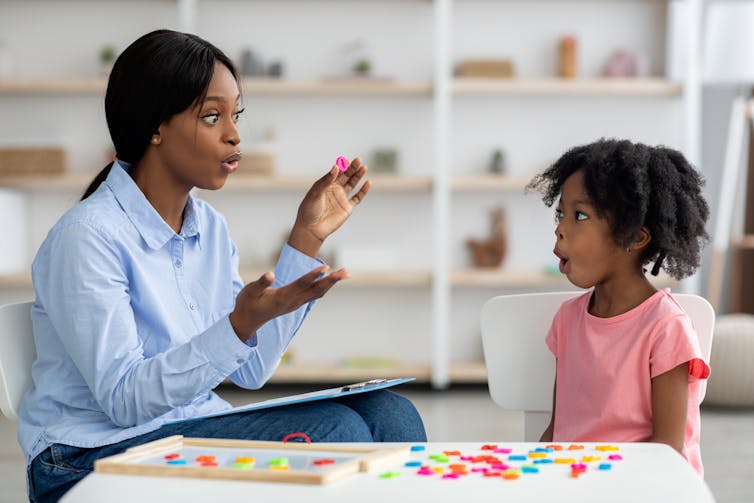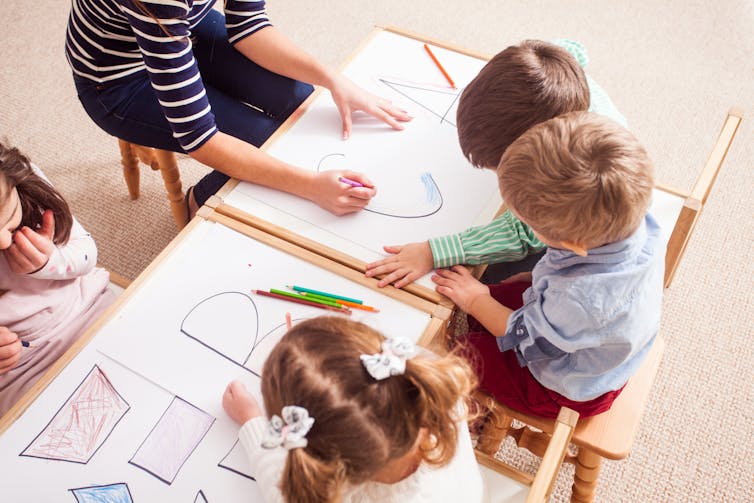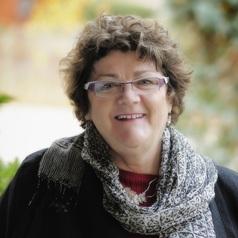Think back to one of your fondest memories of play. Where were you, who were you with, what powers did you pretend to have? Would you like to go back there if you could, if only for a moment?
Unfortunately, fewer and fewer children are having the opportunity to have experiences like this, which is disturbing for many reasons.
Key among these is that play makes children (and people of all ages) happy, and our society is seeing happiness deprivation. Along with many others who work in health, as a child psychiatrist I am deeply concerned about this. Mental illness among children and adolescents has gone up and some mental health researchers are making a link to play deprivation.
Dr. Jean Clinton speaks at a mental health and schools conference hosted by the B.C. Ministry of Education and Child Care.
Ontario recently announced there will be a new kindergarten curriculum that focuses on back-to-basics for literacy in response to the province’s Right to Read inquiry, which called for changes to reading education.
Ontario’s education minister has said a play-based approach will remain part of kindergarten. But some early childhood experts fear we will see an increased “schoolification” of kindergarten — and an end to a rich environment where educators support children’s curiosity and play-based inquiry.
Our children can flourish and learn how to read if classrooms embrace “playful learning” — inquiry-based, play-based activities that are supported by educators, with some direct instruction. However, the success of this type of learning will depend on several factors.
Importance of playful learning
Learning to read does not come naturally. Reading requires developing new neural pathways. This requires some direct instructions for the development of specific skills, and this can be done through playful learning that need not mean a loss of play.
This will depend on:
-
the kindergarten team (comprised of a teacher and early childhood educator) fully understanding their roles and the new curricula priorities;
-
the team knowing how to support play-based learning in the classroom, and mapping out how they will combine some direct instruction with rich play- and inquiry-based activities;
-
the team being sufficiently equipped and resourced. Ideally, this would mean being supported by a literacy coach well-versed in evidence-based learning strategies for supporting children’s emerging literacy and for supporting play.
Play is not the opposite of learning
Until fairly recently, many people considered play to be the opposite of work and learning, believing play is done when the real work of learning has been finished. Many still do not understand that playing instead of practising the alphabet or counting is not a waste of valuable time.
But once people know that experiences accompanied by emotional connections are much more memorable, you can organize play in ways that increase the amount of learning. From a neuroscientific perspective, it is clear that play is not frivolous: it changes the brain by enhancing brain structure and function.
Children learn about themselves, the world and so much more through play. From a health perspective, the absence of play, especially outdoor play, leads to rising obesity rates.
Through play, children learn interpersonal skills, how to be a friend and how to solve problems — skills desperately needed in these times of artificial intimacy.
Play promotes thinking, problem solving, impulse inhibition and executive function. These are essential skills for learning how to read.

Experiences are much more memorable when they are accompanied by emotional connections. (Shutterstock)
The science of learning
There has been an explosion in the study of the science of learning which asks: how does the brain learn? Kathy Hirsh Pasek, a professor of psychology at Temple University, with her team, is leading scholars in this science of learning. According to their research, learning happens best when:
-
children are active with “minds on” rather than passively sitting for long periods of time with teacher talking or instructing;
-
they are engaged;
-
the information is meaningful;
-
they are socially interacting;
-
the learning is “iterative,” meaning information or concepts are repeated in varied contexts, and across subject areas, to help children see new ways to combine smaller parts;
-
they are having fun.
Crucial to success is this: teachers must see that a shift towards playful learning is essential for achieving both engagement and academic success. Principals need to be on board and supportive of this approach.

Positive social interaction fosters children’s learning. (Shutterstock)
Teacher-guided play
Not all play is the same when it comes to learning. Teachers need to understand the different types of play as described and researched by child development professor Angela Pyle. As her work outlines, play is considered to be on a continuum from free play to guided play to formal games. Teacher-guided play is where the teacher sets up contexts (“provocations”) for the children and the educator to develop language, literacy and mathematical pursuits under the educator’s guidance.
Teacher-guided play puts more emphasis on particular learning goals such as literacy and numeracy skills while still embedded in a playful learning context. Adults thus become the support team, but not the directors, of guided play.
Protecting the loss of childhood
Let’s remember, play time across the world has diminished. British education advocate Sir Ken Robinson famously said that felons in jail have more outdoor play time daily than children on average across the globe spend outside playing.
Education researcher Pasi Sahlberg discusses the importance of play in a Froebel Trust lecture.
A 2022 survey by the NGO Save the Children in the United Kingdom found just 27 per cent of children said they regularly play outside their homes, compared to 71 per cent of the baby boomer generation. For those aged specifically between 55 to 64, it was 80 per cent, showing that rates of play have declined steadily in just a few generations. Research from other countries has also documented how an increasing sense of business in children’s lives has also crowded out play.
Parents may need to be encouraged to support playful learning approaches at school in face of the “crowd appeal” of back to basics.
We must recognize that play and connected relationships are critical for children’s well-being. There is nothing more basic than the right to belong and the right to play.



 Do you have 7,513 unread emails in your inbox? Research suggests that’s unwise
Do you have 7,513 unread emails in your inbox? Research suggests that’s unwise  Gym hygiene guide: the dangerous bacteria that lurk in dirty fitness equipment and clothes
Gym hygiene guide: the dangerous bacteria that lurk in dirty fitness equipment and clothes  Our laser technique can tell apart elephant and mammoth ivory – here’s how it may disrupt the ivory trade
Our laser technique can tell apart elephant and mammoth ivory – here’s how it may disrupt the ivory trade  South Africa’s youth are a generation lost under democracy – study
South Africa’s youth are a generation lost under democracy – study  Ukraine recap: US$60 billion aid package brings fresh hope to desperate Kyiv
Ukraine recap: US$60 billion aid package brings fresh hope to desperate Kyiv  What is meaningful work? A philosopher’s view
What is meaningful work? A philosopher’s view  What kind of diner are you? 6 types of diners who avoid plant-based meat dishes
What kind of diner are you? 6 types of diners who avoid plant-based meat dishes  Fuel poverty in England is probably 2.5 times higher than government statistics show
Fuel poverty in England is probably 2.5 times higher than government statistics show  Why is China risking US sanctions by arming Russia?
Why is China risking US sanctions by arming Russia?  Tarantino abandons his tenth film – five other times Hollywood giants cancelled big projects
Tarantino abandons his tenth film – five other times Hollywood giants cancelled big projects  Is attachment theory actually important for romantic relationships?
Is attachment theory actually important for romantic relationships? 































